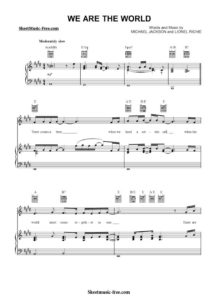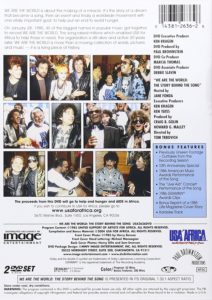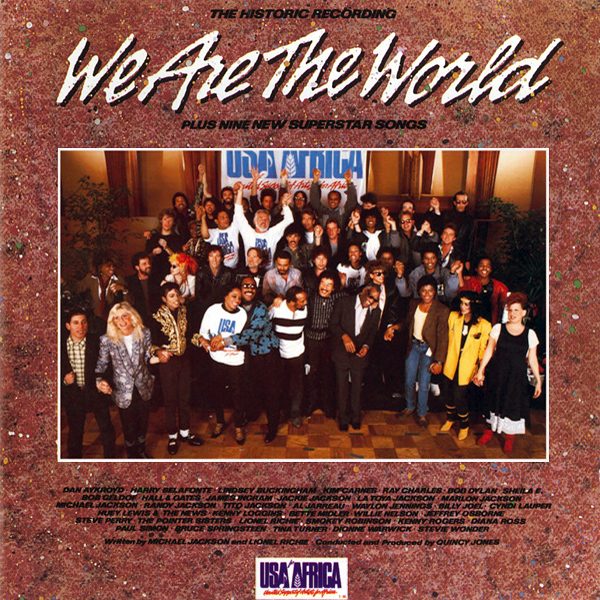“We Are the World” is a song and charity single originally recorded by the supergroup United Support of Artists (USA) for Africa in 1985. It was written by Michael Jackson and Lionel Richie (with arrangements by Michael Omartian) and produced by Quincy Jones for the album We Are the World. With sales in excess of 20 million copies, it is one of the fewer than 30 all-time physical singles to have sold at least 10 million copies worldwide.
Following Band Aid’s 1984 “Do They Know It’s Christmas?” project in the United Kingdom, an idea for the creation of an American benefit single for African famine relief came from activist Harry Belafonte, who, along with fundraiser Ken Kragen, was instrumental in bringing the vision to reality. Several musicians were contacted by the pair, before Jackson and Richie were assigned the task of writing the song. The duo completed the writing of “We Are the World” seven weeks after the release of “Do They Know It’s Christmas?”, and one night before the song’s first recording session, on January 21, 1985. The historic event brought together some of the most famous artists in the music industry at the time.
The song was released on March 7, 1985, as the only single from the album. A worldwide commercial success, it topped music charts throughout the world and became the fastest-selling American pop single in history. The first ever single to be certified multi-platinum, “We Are the World” received a Quadruple Platinum certification by the Recording Industry Association of America.
Awarded numerous honors—including three Grammy Awards, one American Music Award, and a People’s Choice Award—the song was promoted with a critically received music video, a home video, a special edition magazine, a simulcast, and several books, posters, and shirts. The promotion and merchandise aided the success of “We Are the World” and raised over $63 million (equivalent to $141 million today) for humanitarian aid in Africa and the US.

Following the devastation caused by the magnitude 7.0 Mw earthquake in Haiti on January 12, 2010, a remake of the song by another all-star cast of singers was recorded on February 1, 2010. Entitled “We Are the World 25 for Haiti”, it was released as a single on February 12, 2010, and proceeds from the record aided survivors in the impoverished country.
“I think what’s happening in Africa is a crime of historic proportions … You walk into one of the corrugated iron huts and you see meningitis and malaria and typhoid buzzing around the air. And you see dead bodies lying side by side with the live ones. In some of the camps you see 15 bags of flour for 27,000 people. And I assume that’s why we’re all here tonight.” — Bob Geldof, addressing his fellow USA for Africa musicians during one of the recording session of “We Are the World” on January 28, 1985.
“We Are the World” is sung from a first person viewpoint, allowing the audience to “internalize” the message by singing the word we together. It has been described as “an appeal to human compassion”. The first lines in the song’s repetitive chorus proclaim, “We are the world, we are the children, we are the ones who make a brighter day, so let’s start giving”. “We Are the World” opens with Lionel Richie, Stevie Wonder, Paul Simon, Kenny Rogers, James Ingram, Tina Turner, and Billy Joel singing the first verse. Michael Jackson and Diana Ross follow, completing the first chorus together. Dionne Warwick, Willie Nelson, and Al Jarreau sing the second verse, before Bruce Springsteen, Kenny Loggins, Steve Perry, and Daryl Hall go through the second chorus. Co-writer Jackson, Huey Lewis, Cyndi Lauper, and Kim Carnes follow with the song’s bridge. This structuring of the song is said to “create a sense of continuous surprise and emotional buildup”. “We Are the World” concludes with Bob Dylan and Ray Charles singing a full chorus, Wonder and Springsteen duetting, and ad libs from Charles and Ingram.
[wiki] https://en.wikipedia.org/wiki/We_Are_the_World
“A great song lasts for eternity,” says Quincy Jones, who produced the track. “I guarantee you that if you travel anywhere on the planet today and start humming the first few bars of that tune, people will immediately know that song.”

Stevie Wonder was originally was supposed to be Richie’s co-writer. “I was really trying to get in touch with Stevie and couldn’t do it,” Richie says. “Stevie was touring a lot. He was doing a lot of stuff.” A phone call with Jones got him and Jackson involved. “I got Michael before I could get Stevie,” Richie says. “We said, ‘If Stevie calls me back, we’ll get him in. In the meantime, I think we can get it done with Michael.’ ”
Richie and Jackson listened to national anthems to get in the proper frame of mind to write. “We didn’t want a normal-sounding song,” Richie says. “We wanted bombastic, the biggest thing you got.” Knowing they needed to create something that immediately sounded important and had global appeal, they prepped for their songwriting sessions by listening to national anthems from several countries, including the USA, England, Germany and Russia. “We put all that into a pot in our heads and came up with a rhythm that sounded familiar, like a world anthem. We wanted people to feel like it was a familiar song. Once we got that — show business, man.”
The We Are the World recording session caused Richie to forget the American Music Awards. Maybe it was just sleep deprivation — after all, the session began at 9 p.m. and lasted 12 hours — but Richie claims to have no memory of hosting that night’s American Music Awards ceremony and winning five awards, including favorite pop/rock male artist. “I walked through that door, and I forgot I had done that,” he says. “The group of people in that room was so mind-changing. There’s Bob Dylan, Billy Joel — give me a freaking break. I had never in my life experienced anything like that.”
Most of the singers had never heard the song before walking into the studio. “We did not have MP3s,” Richie says. “We had cassettes back then. We had to send it to you, so most of them had not heard the song.” After all, Richie and Jackson had just barely finished the song in time for the initial tracking session held a week previous at Kenny Rogers’ studio. Even Rogers hadn’t heard it: “We didn’t know what we were going to sing until that night,” he says. Hall & Oates’ John Oates, who sang in the backing choir, says, “It had the anthemic quality and the simplicity of melody that made pulling off a giant ensemble like that very easy to do. And it was a room full of amazing singers, so that wasn’t exactly a problem.”
When Ray Charles spoke, everybody listened. “Ray Charles, being who he was, commanded a certain deference and respect from everyone, even though he didn’t assert himself in any weird way,” Oates says. “He was just standing in the middle, doing his part. Lionel, Michael and Quincy were running the show. It was their song, their production, and everyone was very respectful, trying to make it happen. There were moments when people — and I will not name names because it’s not worth it — in the chorus started to put their producers’ hats on. They started to say, ‘What if we did this?’ and ‘What if we did that?’ Coming up with ideas. It was obvious it was a complicated thing to pull off in general, and having too many cooks in the stew would be a giant catastrophe. Ray, every once in a while, would just pipe up: ‘C’mon. Hey. Let’s go. Listen to Michael. Let’s get this thing done.’ He was there to sing, and he sensed that it could go south very quickly. He commanded a lot of respect, and I thought that was very cool.”
Bob Dylan was nervous about singing his solo. In a one-hour behind-the-scenes documentary produced to coincide with the release of We Are the World, there’s a surreal scene in which Stevie Wonder sits at the studio piano, imitating Bob Dylan to Bob Dylan to help him get the phrasing for his “There’s a choice we’re making” solo phrase. “Dylan turned to me and Stevie and said, ‘How do you want me to sound?’ Richie recalls. “We were all kind of doing it, and we wanted to make sure we didn’t insult anybody.” Oates, who stood directly behind Dylan while the chorus was recording, remembers him being anxious about singing his solo. “He’s not a melodic guy, and it was a very specific melody,” Oates says. “I think he felt uncomfortable singing that particular melody, and he worked around it in his own way.”
Kenny Rogers wanted to get everybody’s autograph. “Once we sang it all the way through and realized how well-thought-out it was, we realized it was something special,” Rogers says. “So I took a sheet of music from the session and started getting people to sign it. Once I started, Diana Ross started, then everybody was running around trying to get everybody. It’s framed on the wall of my house in Atlanta.” Oates, who also got an autographed chart, echoes Rogers almost word for word: “I have it framed in my studio in Colorado. When people come in and see it, they freak. I made sure I got everybody. I even got Ray Charles and Stevie Wonder to sign it. For once, I had the presence of mind to do something like that, and it’s one of my most treasured possessions.” Jones’ signed sheet music hangs in his den: “It always makes me smile when I look at it and start reading those names.”
That “Check your egos at the door” sign turned out not to be necessary. That’s what Jones says. “Here you had 46 of the biggest recording stars in the entire world in one room, to help people in a far-off place who were in desperate need,” he says. “I don’t think that night, that experience, will ever truly be duplicated again. I know and believe in the power of music to bring people together for the betterment of mankind, and there may be no better example of this than the collective that was We Are the World.”
USA for Africa is still around. Thirty years after We Are the World, USA for Africa still works on behalf of communities in Africa. Recent initiatives have addressed climate-change issues, arts campaigns and the shipment of medical supplies to Liberia and Sierra Leone to combat the spread of ebola. Royalties from We Are the World continue to be the organization’s primary source of funding. “We still earn, but certainly not the kind of money we earned 25 years ago,” says executive director Marcia Thomas, who joined the non-profit in 1986 to work on Hands Across America, another USA for Africa initiative. “Our biggest support in terms of where We Are the World is bought most frequently is not in the U.S. but other parts of the world, primarily Japan and Asia.”


Recent Comments